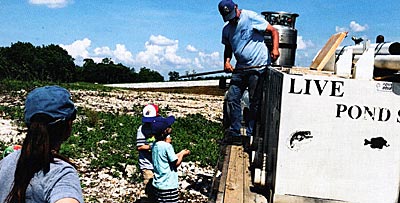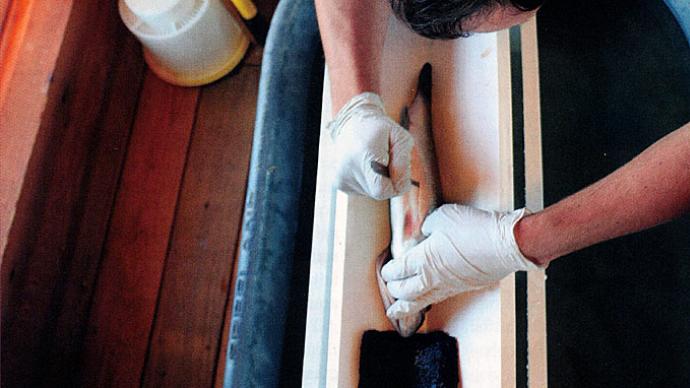
I'll soon start my 40th year as a private sector fisheries biologist. Forty years. Trust me, I'm not that old. At least it doesn't seem that way. I remember 1980. It was the hottest summer on record where I was. That was the year the state of Texas stopped giving away free fish. That was also about the time baby boomers were coming of age. Coming of age meant they'd long since moved away from the farms and ranches to get college degrees and establish careers. Many of those careers blossomed, especially in the big cities, and some of those who followed their American dream and worked their proverbial butts off, had this thing called disposable income. These weren't necessarily folks who followed traditional trails toward jobs where they sold their time. These were people who took risks, or sought those higher educations and molded their professions, and figured out how to play the game in the fast-pace world around them.
Longing to escape their concrete jungles as they moved into their forties and fifties, many of these folks wanted to go back in time, to those family farms and small ranches with simple, rural work ethic and reward, to productively sequester away from the sounds of sirens, traffic, and the general hustle-bustle that seems to dominate that city lifestyle. They didn't necessarily wish to derive income from that land as much to give back, make an investment, and create a place to sense their roots. Many of them wanted to provide family time for their kids to see a different side of life and help the next generation develop a different set of life standards, even if just for comparison to city life.
Ponds and lakes and wildlife play a significant role in what these folks wanted from their land investments. Fun was, and still is, important. Back in the 1980s it seemed that people were interested in finding a place to invest their money, kind of like a living piggy bank, and enjoy the place as they raised the kiddos. In the early 80s, pond management didn't exist. It was more like calling the dozer guy to push some dirt around a low spot and dig a tank for watering livestock. In the mid-80s, sport fish hatcheries began to emerge and provide a supply line for different stockings of different species of fish. People began buying those fish with a purpose and wanting to do some things to take care of them. That's about the time professional bass fishing truly began filling our awareness levels, and stores like BassPro Shops began to blossom. In those years, pond management was about having a decent fishing hole, and the fundamentals of caring for it. What that meant was stocking fish, dealing with runaway vegetation, fertilizing, and rudimentary electrofishing surveys and fisheries analysis. Maybe a supplemental feeding program helped us to see those huge catfish as they vacuumed the morsels of the top.

As the 80s progressed, so did the egos of land management. Growing huge deer became a competitive game, especially in states like Texas. Not far behind came the idea of growing bigger bass.
Egos hit full stride in the early 1990s as fast bass boats, a thriving economy, and crowded public lakes pulled the trigger in men's minds whose crosshairs were focused on all things bigger. Pond management was beginning to evolve into an industry and new tools were beginning to show up. Not only could we fertilize ponds that needed it, we could add some supplemental fish food, maybe even buy a feeder and stock some genetically superior fish. When several state record Largemouth bass were caught around the nation, private landowners wanted some of that. In that day, good genetics, a basic food chain, better knowledge of managing the dynamics of a fishery, and selective ways to manage aquatic plants better served that notion of bigger fish. Toward the end of the 90s, water management started becoming a bigger deal. Aeration systems were being developed, crossing the boundary from waste water treatment. Along the way, pond managers were learning the biggest lesson of all—habitat. Without habitat, pros were learning, a landowner could try to money-whip even the prettiest of ponds and still wind up with something just north of mediocrity.
For some hilarious reason, "Y2K" still sticks in my brain. When 1999 ticked over into 2000, with all the concern about computers crashing, clocks stopping, and the technical world as we knew it sliding off into some unknown hole of cyberspace, pond management started showing signs of refinement.
People started paying more attention to the details.
In retrospect, landowner egos still seemed to drive the goals of growing huge fish as they pushed their ponds toward a higher carrying capacity and standing crop.
But, the trend evolved into focusing on the finer details of basics of managing those prime private waters.
First up was habitat. At the turn of the most recent century, habitat was simply considered structure for game fish. Pondmeisters took turns designing the best fish attractors their imagination and back pockets could afford. I remember a lake Pond Boss Founding Editor, Mark McDonald, leased. It's nickname? Lake Junkpile. It was loaded with cool fish attractor stuff, like rocks, old tires, and pipe—lots of pipe. That stuff attracted fish. Fish attracted more lessors and made that little fishing club an attractive place not far from a big city. Lake Junkpile epitomized private pond management of the day. Provide structure for your best fish. Habitat for all other fish was just a lucky consequence.
During that span of time, more pond management tools began to tempt the marketplace. Microbes were becoming an item. Beneficial bacteria were coming of age, whether in some proprietary mix similar to those gallon jugs of protein powder at the health food store, or little packets you just toss in the water and watch melt before your very eyes as the water magically absorbs the little pacman water helpers. There were several companies manufacturing aeration systems, but the early 2000s saw a spike in numbers of those companies. Their offerings, to this day, run the gamut from the fanciest of fountains to water movers to bottom-diffused aeration systems working off high volume, low pressure air compressors. During the mid-2000s, fish food started coming of age. That's probably due, in some part, to the fast food industry and an expansion of the immediate gratification trends of society. Nonetheless, Purina Mills took the lead to create fish food specifically for the sport fish industry and private waters.
Water chemistry and its influence on biology and natural eutrophication have become the latest trend in pond management.

I had a great conversation recently with Mac McCune, founder of Lake Management Services in Houston, Texas. I asked Mac to reflect on the past 40 years and fast forward to today. His answer was quick. "Way back then, it was livestock ponds, add a few fish, and enjoy it." Then he said, "Today is totally different. In the 90s, guys were trying to fill their egos with big fish. Now, pond management is more about detail and the technical side of things."
He's spot on. With advancing tools, today's pond manager has many more professional companies, experts, and online information to draw from, as well as an ever-emerging industry providing better tools, products, and services to get pondmeisters where they want to go. Microbes are now custom-designed for that particular pond; aeration systems are engineered to turn water over and over at a specified rate for that body of water. Egos don't seem to be as big a deal as they were in the 90s. That doesn't mean people don't want to grow huge fish. They still do. It means people are equally as interested in the ecosystem of their ponds as a whole and see bigger fish as a fantastic fringe benefit.
Details are where it's at today. Details of habitat design—making sure spawning beds are adjacent to nursery grounds and not far from that structure that everyone seems to understand. Details about managing water quality—not only do people try to manage the nutrient levels of their precious waters, they now pay attention to balancing those nutrients to prevent things such as blue-green algae via monitoring chemistry and biology. Aeration and microbes assist that important mission. Details about aquatic plants— diversity of native species rides in the forefront of pond management attitudes today. Details about fish management—not long ago, it was a general rule that all lakes must have some type of harvest. Today, harvest is selective, not only for specific sizes offish, but for body condition and aggressive behavior. Details, details, details.
To what end?
Here's where I see this going. Pond management has always been about 10% science and 90% art. Today, attention to science and the details associated with the dynamics of all the different elements of a pond have begun to shift that paradigm ratio.
It's probably closer to 20% science in today's world.
And, pond management continues to trend upward.
Reprinted with permission from Pond Boss Magazine



